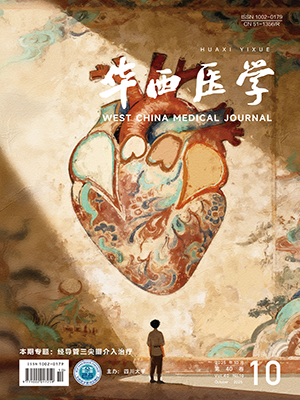| 1. |
管向东, 刘紫锰. 2013《呼吸机相关性肺炎诊断、预防和治疗指南》——目标性治疗的解读. 中华医学杂志, 2014, 94(5): 333-334.
|
| 2. |
中华医学会重症医学分会. 呼吸机相关性肺炎预防、诊断及指南. 中华内科杂志, 2013, 52(6): 1-20.
|
| 3. |
刘庭芳, 刘勇. 中国医院品管圈操作手册. 北京: 人民卫生出版社, 2012: 1.
|
| 4. |
周藜藜, 王维, 赵瑜, 等. 品质管理圈在提高胃肠减压有效率中的应用. 华西医学, 2015, 30(4): 754-757.
|
| 5. |
陈林, 廖周谊, 李超, 等. 品质管理圈在血液透析中心护士手卫生管理中的应用. 华西医学, 2015, 30(5): 929-932.
|
| 6. |
陈启花, 付琴, 刁永书. 品质管理圈活动在病区药品管理中的效果观察. 华西医学, 2015, 30(8): 1514-1517.
|
| 7. |
Institute for Healthcare Improvement. Getting started kit: prevent ventilator-associated pneumonia: how-to guide. Crit Care Nurs Q, 2006, 29(2): 157-173.
|
| 8. |
Abbott CA, Dremsa T, Stewart DW, et al. Adoption of a ventilator-associated pneumonia clinical practice guideline. Worldviews Evid Based Nurs, 2006, 3(4): 139-152.
|
| 9. |
彭小贝, 虞玲丽, 李映兰, 等. 品管圈在提高重症监护病房护士手卫生依从性中的应用. 中国感染控制杂志, 2015, 14(12): 862-864.
|
| 10. |
李天民, 邓静, 王化宇, 等. 品管圈在呼吸机冷凝水管理中的应用. 中国感染控制杂志, 2015, 14(10): 713-714.
|
| 11. |
邓慧琴, 刘新玲, 马敏. 运用品管圈提高患者床头抬高依从率. 中国感染控制杂志, 2015, 14(4): 262-264.
|
| 12. |
谭创. 品管圈活动对机械通气患者呼吸机相关性肺炎的影响. 中国实用护理杂志, 2015, 21(15): 118-119.
|
| 13. |
梁翠娥. 品管圈在降低 ICU 呼吸机相关性肺炎患者感染中的应用. 齐鲁护理杂志, 2014, 20(23): 30-31.
|
| 14. |
李喜元, 尹吉东, 王东信, 等. 品管圈活动在降低呼吸机相关性肺炎的应用效果. 临床荟萃, 2014, 7(7): 812-814.
|
| 15. |
郑秋霞, 彭根英, 张宁, 等. 品管圈管理对降低 ICU 呼吸机相关性肺炎的效果. 中国消毒学杂志, 2014, 31(5): 522-523.
|
| 16. |
Resar R, Pronovost P, Haraden C, et al. Using a bundle approach to improve ventilator care processes and reduce ventilator-associated pneumonia. Jt Comm J Qual Patient Saf, 2005, 31(5): 243-248.
|
| 17. |
赵娜, 崔文香. 集束化护理措施预防呼吸机相关性肺炎效果评价的 Meta 分析. 中国实用护理杂志, 2014, 30(10): 20-24.
|
| 18. |
Labeau S, Vandijck D, Rello J, et al. Evidence-based guidelines for the prevention of ventilator-associated pneumonia: results of a knowledge test among European intensive care nurses. J Hosp Infect, 2008, 70(2): 180-185.
|
| 19. |
Gastmeier P, Geffers C. Prevention of ventilator-associated pneumonia: analysis of studies published since 2004. J Hosp Infect, 2007, 67(1): 1-8.
|




